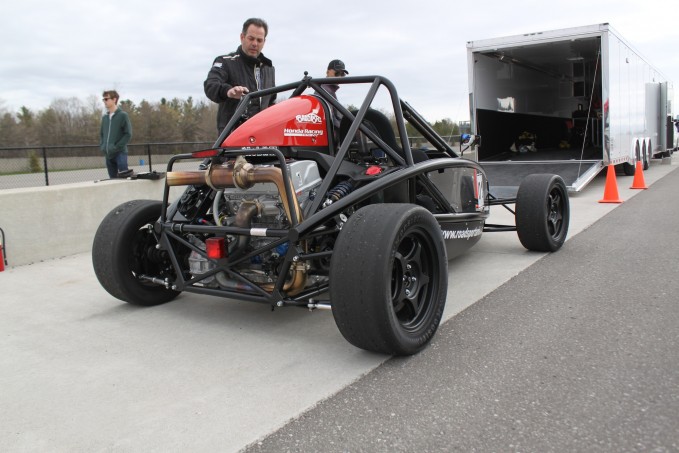I still remember the first time I hit the track in a dedicated machine. As I walked up to the Van Diemen Formula SCCA race car, I distinctly remember hearing my heartbeat up in my throat.
Sliding into the tight cockpit seemed like it took forever, though in reality, it took just a second or two. When it fired up to life, the pure raw energy of the engine vibrated the sheetmetal and helped to hide the nervous, nearly fright-induced tremors in my hand. I distinctly remember my clutch foot being unable to stay still. Now, nearly four years later, I’m on the same track, looking face-to-face at a potentially more intimidating vehicle – the all new Spec: RaceAtom from Ariel.
Right off the bat, I’ll admit there are jitters somewhere in my body trying to creep to the surface like that original experience. But now, I’m older, more experienced and have a better understanding of the respect these track cars deserve, and how to handle them while having a good – not frightening – time. But yes, that thump-thumping lump is somewhere in my body, but it’s being overshadowed by the sheer joy and playful energy that the Ariel Atom produces.
Part of the fun is the Atom’s design. It’s an open-wheel setup, just like the pros use on TV, but it features a sexy exoskeleton that allows you to see all the inner workings of the car. That means you can see the Honda-sourced 2.4-liter four-cylinder engine and six-speed manual transmission in action. And you can see all the suspension bits working right before your eyes. Of course, I only had the chance to see that while I was riding shotgun; which was a thrilling experience that rivals any roller coaster I’ve ever been on (and I love roller coasters). Somehow, despite having a helmet to shield my face from the elements that could abuse me at the speeds we were achieving in the Atom, my eyes were still watering, as if my retinas and brain couldn’t process what was happening in front of me.
While it was fun in the passenger seat, it’s even better in the driver seat. That 2.4-liter Honda engine is plucked right from the Civic Si, and while it doesn’t sound like anything too exotic, the familiar engine features a wonderfully high redline and also sports a bulletproof reputation in terms of reliability and low-cost maintenance. The same can be said about the six-speed manual, which is also a common Honda Civic Si component. The shifter in the Civic Si is one of the highlights of the vehicle, and it’s a fantastic part of the Atom.
Of course, don’t think that since the Atom uses pedestrian Honda parts, it’ll be like driving a boring old Civic. This is a car that weighs just more than 1,300 lbs and the 2.4-liter engine makes 230 hp in here, meaning that 60 mph is achieved from a standstill in about 3 seconds. There are no exotic parts or materials used here either, helping again to keep costs (and weight) low.
Jumping into the Atom can’t be done gracefully. There are no doors and the tubular frame is quite tall to vault my legs over. I place both feet onto the seat and slide my butt into place. Good thing my shoes were clean. I get harnessed in, attach the steering wheel to the column and take note of the fire extinguisher in case things get extreme. At that point, I start to realize that maybe this won’t be an experience easily relatable to the other cars I’ve driven on track, except those scary Van Diemen race cars.
Placing my feet on the Wilwood drilled aluminum pedals, I brace myself to get started. The steering wheel, although somewhat slim, is heavy — no power steering assistance here. The engine fires up but it’s noticeably lacking character. At its worst, it sounds like a super-powered vacuum, at its best, it sounds like a Honda Civic f
rom the Fast and Furious days.
The throttle response, however, is perfect with no delay, lag or hesitation. It’s direct, the engine goes harder and the car moves faster the further you bury your foot into the right pedal. The steering, too, despite the intimidating weight at low speeds, is direct with the front wheels following exactly where you point the wheel.
And then there’s the grip that goes with it. The Hoosier slicks might as well be coated with glue, as the car just sticks to the road. The light nose and weight over the rear means that the car likes to be more of a point-and-shoot machine, but if you need some extra rotation, a little extra throttle will do the trick. And when things do get too fast, the Wilwood brakes slow things down in a convincing manner.
The first few laps are thrilling, but after I get used to the noises, vibrations and how the track feels in a car this engaging, the next few laps are thoroughly enjoyable. The Atom becomes a teaching tool, as if it says: “You can go faster now” and “Give me a bit more steering angle” or “Less brakes needed there.” Like a very patient and effective coach, the car is simple in its communication, I can understand exactly the effect of each of my inputs.
And that’s exactly what this car is supposed to do, as the Ariel I drove here isn’t just a normal Atom 3 or more powerful 3S, but the Spec: RaceAtom. A track-only toy coming in at $53,750, Ariel also features a spec race series that runs at Atlanta Motorsports Park, Virginia International Raceway and INDE Motorsport Ranch.
The Verdict: 2016 Ariel Atom Track Test
A wholly capable and fun track car, the Ariel Atom experience is improved with the knowledge that it’s most important parts are among the most well-respected and durable in the world of cars. The fact that these track toys can also compete in a fair and safe way against each other is another big benefit. While other amateur and professional racers may opt for the cheaper MX-5 Cup car, the Spec: RaceAtom is lighter and more powerful, while being just as easy to drive.














